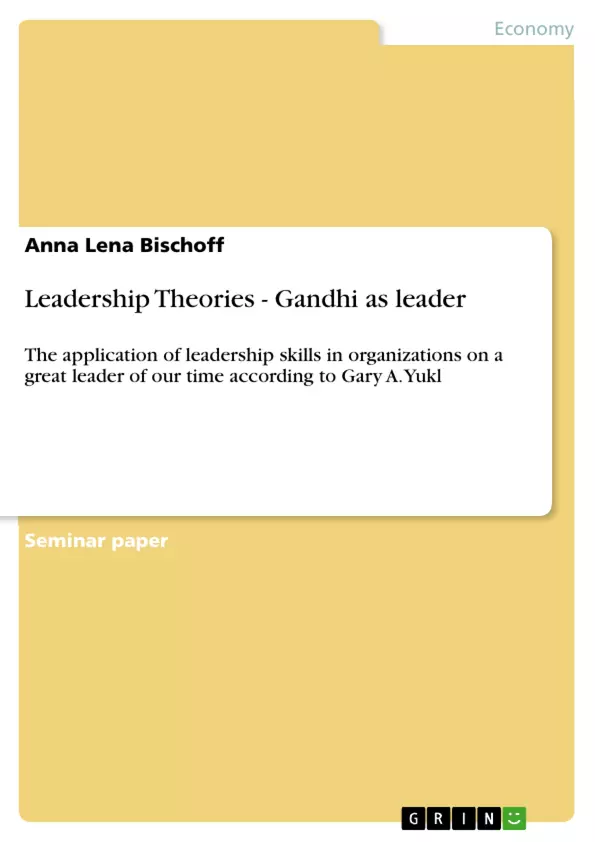What makes a great leader great? What kind of skills does he use? Why are people still recognizing him for his behavioral skills? Is it possible to replicate those e.g. in business life?
Gandhi was a leader of one of a kind. Not only did he see himself not as leader, but someone to help people reach their highest goals. He was truly inspirational and stood up for ethical values that all too often got lost nowadays. Still many people worship them and would like to live up to them. His values and beliefs can easily be applied in business life by treating every human as such and are a wakeup call to organizations. As recent events as for instance the Financial Crisis have shown us, thinking about profit without moral behaviour will lead to devastating results.
This work is mainly based on "Leadership in Organizations" by Gary A. Yukl and "The Three Faces of Leadership" by Hatch et al.
Table of Contents
- Introduction
- Chapter 1: Description of Gandhi
- Chapter 2: Gandhi as a leader
- 2.1 Ethical leadership
- 2.2 Servant leadership
- 2.3 Spiritual leadership
- Chapter 3: Gandhi in business life
Objectives and Key Themes
This paper aims to analyze the leadership skills of Mohandas Karamchand Gandhi, a prominent 20th-century leader, using the framework of Gary A. Yukl's "Leadership in Organizations." It explores whether Gandhi's methods are replicable in modern business contexts. The analysis focuses on the effectiveness and applicability of his leadership approach.
- Gandhi's ethical leadership principles and their application.
- The role of non-violent resistance in Gandhi's leadership.
- The applicability of Gandhi's leadership style to modern business settings.
- An evaluation of Gandhi's impact on the Indian independence movement.
- Critical assessments of Gandhi's leadership and legacy.
Chapter Summaries
Chapter 1: Description of Gandhi: This chapter provides a biographical overview of Mohandas Karamchand Gandhi, highlighting his role as a political, spiritual, and ideological leader in India. It details his key principles: Satyagraha (truth), Ahimsa (non-violence), and Swaraj (self-rule). The chapter traces Gandhi's journey from his legal studies in London to his experiences with discrimination in South Africa, which shaped his philosophy of non-violent resistance. His significant role in the Indian Independence Movement, culminating in the Salt March, is also described. The chapter also mentions criticisms regarding the limitations of his support to only Indian people and accusations of racism.
Chapter 2: Gandhi as a leader: This chapter analyzes Gandhi's leadership skills through the lens of Gary A. Yukl's "Leadership in Organizations," focusing on ethical, servant, and spiritual leadership. It examines how Gandhi's actions reflect these leadership theories, emphasizing his emphasis on values like honesty, altruism, and compassion. The chapter explores how Gandhi's approach of influencing people through reason rather than force demonstrates his effective leadership style. It further questions the ethical implications of his civil disobedience while arguing that his non-violent approach set a precedent for global social change.
Keywords
Gandhi, leadership, ethical leadership, non-violent resistance, Satyagraha, Ahimsa, Swaraj, Indian Independence Movement, civil disobedience, servant leadership, spiritual leadership, moral development, power, influence.
FAQ: A Comprehensive Language Preview of Gandhi's Leadership
What is the main topic of this text?
This text provides a comprehensive overview of Mohandas Karamchand Gandhi's leadership, analyzing his skills and strategies within the framework of ethical, servant, and spiritual leadership theories. It examines the applicability of his methods to modern business contexts and explores both his successes and criticisms.
What does the Table of Contents include?
The table of contents covers an introduction, a chapter describing Gandhi's life and principles, a chapter analyzing his leadership style (including ethical, servant, and spiritual aspects), a chapter on Gandhi's relevance to business, and a concluding chapter (implied).
What are the key objectives and themes explored?
The text aims to analyze Gandhi's leadership using Gary A. Yukl's framework, exploring the replicability of his methods in modern business. Key themes include Gandhi's ethical principles, the role of non-violent resistance, the applicability of his style to modern business, his impact on the Indian independence movement, and critical assessments of his legacy.
What are the key themes covered in Chapter 1?
Chapter 1 offers a biographical overview of Gandhi, emphasizing his key principles (Satyagraha, Ahimsa, Swaraj), his experiences in South Africa, his role in the Indian Independence Movement (including the Salt March), and some criticisms of his actions, including limitations of his support and accusations of racism.
What are the key themes covered in Chapter 2?
Chapter 2 analyzes Gandhi's leadership through the lens of ethical, servant, and spiritual leadership theories. It examines how his actions reflect these theories, highlighting his emphasis on values like honesty, altruism, and compassion, and explores the ethical implications of his civil disobedience and its impact on social change.
What keywords are associated with this text?
Keywords include Gandhi, leadership, ethical leadership, non-violent resistance, Satyagraha, Ahimsa, Swaraj, Indian Independence Movement, civil disobedience, servant leadership, spiritual leadership, moral development, power, and influence.
What leadership styles are analyzed in relation to Gandhi?
The text analyzes Gandhi's leadership through the lenses of ethical leadership, servant leadership, and spiritual leadership.
How does the text approach the analysis of Gandhi's leadership?
The text uses a structured approach, employing the framework of Gary A. Yukl's "Leadership in Organizations" to analyze Gandhi's leadership style and its effectiveness.
What is the intended audience for this text?
The text appears intended for an academic audience interested in leadership studies, Gandhian philosophy, and the application of historical leadership models to contemporary contexts.
What is the practical application of this analysis?
The analysis explores the potential applicability of Gandhi's leadership style to modern business settings, prompting reflection on the relevance of ethical and non-violent approaches in contemporary leadership.
- Quote paper
- Anna Lena Bischoff (Author), 2010, Leadership Theories - Gandhi as leader, Munich, GRIN Verlag, https://www.hausarbeiten.de/document/161872


